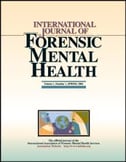 Canadian judges who consider violence risk assessment cases appear to express various preferences regarding an expert’s qualifications, the procedures used, and the nature of the findings. This is the bottom line of a recently published article in International Journal of Forensic Mental Health. Below is a summary of the research and findings as well as a translation of this research into practice.
Canadian judges who consider violence risk assessment cases appear to express various preferences regarding an expert’s qualifications, the procedures used, and the nature of the findings. This is the bottom line of a recently published article in International Journal of Forensic Mental Health. Below is a summary of the research and findings as well as a translation of this research into practice.

Featured Article | International Journal of Forensic Mental Health | 2013, Vol. 12, 287-296
Expert Evidence About Violence Risk Assessment: A Study of Canadian Legal Decisions
Author
Jennifer E. Storey, Simon Fraser University
Valerie J. Campbell, Alberta Justice and Solicitor General, Criminal Justice Division, Crown Prosecutor’s Office
Stephen D. Hart, Simon Fraser University
Abstract
In recent decades the practice of violence risk assessment and use of violence risk assessment instruments has become widespread in the criminal justice system. How are courts reacting to these developments? Herein the findings of a survey of Canadian case law are reported. Using Quick Law 35 cases were systematically identified in which judges commented on expert evidence regarding violence risk. Judicial comments were summarized with respect to evaluator qualifications, assessment procedures used, and presentation of findings and opinions. Findings indicate a wide variety of judicial preferences including the skill and knowledge of the evaluator, the type of information used, the description of findings and procedures, and the applicability of legal rules. Although potentially useful to evaluators caution is urged regarding the incorporation of some judicial preferences.
Keywords
Violence risk assessment report, criminal court, police, expert evidence, expert witnesses
Summary of the Research
The current study sought to address the increasing popularity of violence risk assessment in the Canadian legal system and analyze the reactions of the courts using judicial comments on expert evidence. The authors provide background on models of violence risk assessment (actuarial models and structured professional judgment models) and the uses for these tools (release, detainment, commitment, sentencing, etc.). Furthermore, they express the need for a better understanding of judicial opinions and a formulation of guidelines for all experts in court.
“Despite the increased training of professionals and admittance of expert evidence on violence risk assessment no clear guidelines exist regarding the qualifications that evaluators should possess, the appropriate procedure for conducting a violence risk assessment, or the nature of the findings and opinions that should be included in expert evidence on violence risk. Furthermore the guidelines that do exist do not consider judicial preferences” (p. 288).
35 cases from Canada were coded for “(1) the qualifications of the evaluators providing expert evidence, (2) the procedure used to assess violence risk, and (3) the nature of the findings and opinions regarding violence risk. Information regarding these questions was pulled from judicial discussions” (p. 289). The results revealed a recurrent judicial issue with experts who lack “qualifications or specific experience in the areas covered in their evidence” (p. 290). In other words, judges prefer to see an evaluator who clearly meets the credentials for someone qualified and capable to conduct a violence risk assessment. ‘Qualified’ and ‘capable’ are subjective terms, and so evaluators may need to individually provide support for their credibility while ensuring that they are testifying only when they have expertise in the area. The authors imply that better guidelines regarding qualification might be necessary.
In addition, some cases indicated judicial concerns regarding the skill set of violence risk assessment evaluators: “Three of the judges valued practical or applied experience over formal training (i.e., education), emphasizing the number of violence risk assessment reports that the evaluators had authored. Conversely, the fourth judge implied a preference for formal training when comparing a police sergeant to a psychologist” (p. 290). Regardless, it is evident that the judges involved in this sample of cases valued a high degree of education and/or training.
This article provides details about judicial reports commenting on the information relied upon in violence risk assessment, the specific methods used to assess risk, the information presented to the court, the style and tone of the testimony, and a discussion of relevant legal issues by non-legal professionals. In summary:
- “When assessing the weight to be placed on expert evidence the court considered the evaluator. Skill in the form of training and experience in the violence risk assessment area were viewed as important as was knowledge of the assessment instrument employed” (p. 293).
- “The type of information used to reach an opinion was a common discussion point making clear the importance of basing an assessment on accurate and appropriate information. Thoroughness in reviewing all of the case information as well as peer review of the final product was of importance to some judges. The results were not able to shed light on whether a judicial preference existed for actuarial or SPJ instruments” (p. 293).
- “Judges were interested in knowing what information was relied upon when providing an opinion about violence risk as well as the degree to which that information was relied upon. They held that evidence should be objective and include information about the instruments used and why they were used as well as how the evaluator reached their conclusions” (p. 293).
Translating Research into Practice
The findings of this research provide opportunity for translation into practice. First, the emphasis judges placed on both education and experience of a violence risk evaluator should be taken into account. Results of this research appear to indicate that judges showed a possible preference for experience, but the combination of both education and experience is ideal. For this reason, continued professional development, education, and training should be sought out by evaluators as this will facilitate the potential for accurate, trustworthy assessments, and thereby lead to a better relationship between experts and the courts.
Second, unreliable and questionable evidence is not acceptable in court, but judges appreciated when “evaluators identified the degree to which their conclusions depended on that information and how their conclusions would change without that information” (p. 294). This implies that violence risk evaluators should remain critical of their own work and present any potential uncertainty to the court.
Another important implication of this research is that judges felt it “necessary for evaluators to be able to describe the functioning of the instrument(s) they used” (p. 294); thus, a valuable skill for evaluators is the ability to describe how the violence risk assessment instrument facilitates the conclusions that lead to the evaluator’s final opinion. Again, this highlights the need for continued education and specific training with a detailed understanding of the assessment tools used in practice.
The authors provide additional details about implications for practice and for further research, covering the topics of evaluator familiarity with legal topics, caution when trying meet judicial preferences, and other specifics relevant to the use of violence risk assessment in criminal justice.
This type of research helps to bridge the gap between what evidence judges want in their courts and what mental health professionals are able to offer. “The role of an expert, as stated in R. v. Abbey (2007, 2009), is to provide the judge and jury with an inference that they could not otherwise make due to the technical nature of the subject matter” (p. 288). Some guidelines exist for mental health professionals; however, there appears to be a need for guidelines that encompass the work of other evaluators who conduct violence risk assessments. “Although we recognize that guidelines cannot be primarily based on judicial concerns since judges are not experts in the field of violence risk assessment, their views can provide useful guidance as judges decide whether and to what extent violence risk assessment reports will influence proceedings” (p. 289). By conducting research on the relationship evaluators have with the legal system and reporting those findings, mental health professionals will be able to optimally serve judges and juries to aid in legal decision-making.
Other Interesting Tidbits for Researchers and Clinicians
“The results of the present study reveal two avenues for future research. First, related research in different environments, such as police, mental health or social work environments, could be conducted to investigate how violence risk assessment instruments and the information they provide are incorporated into workplaces and cases, and how the instruments perform in practice. Second, the present study could be replicated in different countries. It is important to determine the extent to which judges’ preferences and decisions are similar across jurisdictions. In addition, such research could eliminate or minimize the limitations of the present study” (p. 295). Since many of the popular violence risk assessment tools have been validated in multiple countries, it would beneficial to conduct this research in other settings. The findings of this study cannot be used to assume that all judges in all jurisdictions hold the same values, and so additional research in new venues is necessary.
Join the Discussion
As always, please join the discussion below if you have thoughts or comments to add!






















